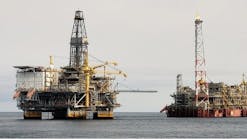View Article as Single page
Offshore Norway application
An operator in the Norwegian Sea used the new cut-and-pull spear to remove the top section of 9⅝-in., 53.5-lb/ft casing to perform a slot recovery operation to make way for a planned open hole side tracking operation in a deviated well. The well intervention team ran the spear to the desired depth of 4,017 ft (1,224 m) in a BHA comprised of the spear and a multi-string cutter. Rotation and upward movement were applied to activate the slips. Rotation was stopped when overpull was recorded and the force of the overpull energized the packing element stack. After the packing elements were actuated, the spear was prepared for the cut by unlocking the mandrel from the rest of the tool. Tension was applied to the casing string, rotation initiated, and the cutting tool cleanly severed the casing at 4,021 ft (1,225 m) in three minutes.
Following some difficulties retrieving the casing from the initial cut point, the well intervention team released the spear without issue by setting down 2,000 lbf (907 kgf) of force and slowly rotating to the right until the spear released and moved down the casing. The team continued rotating 15 more turns, applied set-down weight, and the spear fully disengaged. Rotation was stopped and the string was picked up to neutral weight of 168,000 lb (76,204 kg), and the element was allowed to relax for 10 min. The team pulled up to relocate the spear higher in the casing, at 2,933 ft (894 m), without issue. The spear was then reset in overpull mode. With 343,000 lbf (155,582 kgf) overpull, the 95⁄8-in. casing was released and recovered.
The new spear enabled the operator to set the tool at depth; make a clean casing cut; unset and reposition the spear farther uphole; reset the tool to lock it to the casing ID; and retrieve the top casing section, all in a single trip. Without the spear, the operation would have required two separate runs—the first to cut the casing, and the second to retrieve it—which would have required an estimated 36 hours. Using the cut-and-pull spear to complete the slot recovery operation in a single run saved 19.5 hours of rig time and an estimated $650,000.
Alternate solutions
In the event that cut-and-pull is unsuccessful, the casing stub can be milled using a pilot mill dressed with advanced milling technology (AMT) inserts. Metal Muncher mill and Turbo pilot mills are two alternatives, both of which benefit from an evolution in metallurgy and geometry of tungsten-carbide cutting inserts to improve fracture toughness, wear resistance, and sharpness. The small, uniform chips produced while milling can be easily circulated from the tools.
The AMT G-cutter is the most recent cutting element designed for greater longevity under heavy impact. It has a second cutting edge and a second chip breaker to continue cutting effectively after the initial edge is worn away.
In some multiple-casing-string retrievals, the inner casing is completely cemented far above the elevation that needs to be milled. In these situations, cut-and-pull operations are not feasible, and pilot milling the inner casing is time consuming and costly. A more efficient and cost-effective alternative is to use an AMT section mill to mill the inner casing and an extended-reach section mill to mill the outer casing, effectively milling a section inside a section. This eliminates the need to remove the inner casing from surface. Efficiency is also increased by the step-by-step approach, which allows centralization and stabilization inside the casing being cut.
During the next eight years, more than 800 offshore wells are scheduled for P&A in the UK alone. In the GoM, the current annual well P&A count of 1,200 is expected to continue for several years. Integrated approaches with contingencies to handle the unknowns associated withP&A operations will be critical to the safety, efficiency, and economics of these operations. Already, significant steps have been taken toward minimizing intervention duration. The industry is also pursuing surface spread cost reduction in the form of smaller footprint through a progression toward riserless light well intervention vessels (RLWIV) and cost-effective conveyance, such as coiled tubing smart intervention, and electric wireline and slickline.




